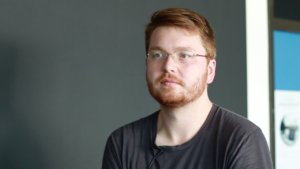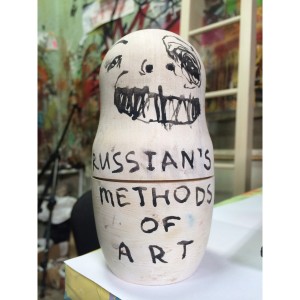For me it is a fact that light is a key medium. But it is actually not the medium that interests me but rather what happens with it or because of it. So light, whether it is interpreted from the physical or philosophical or metaphysical view, is a very small section of the world, which opens as a result. What interests me in the projects, when I specifically inset light, with a varying of success and also referring to the concentration in the projects, is: how can you create a connection, which is immaterial and timeless between buildings and people, between people and people? So it is also about a mediator, about a communicative part. This is often equated with communication design or composition design, perhaps even confused? One may not forget that the function only consists in precisely honoring this one aspect. It is not about looking back on and reappraising German history when I close a synagogue and set the light from inside to the outside, towards the neighbors. The question is rather: what did the neighbors feel? And that is exactly what they told the media, told to the cameras and radio microphones and in the conversations on their own accord, that they themselves felt addressed for the first time. Because in the other projects they were not involved at all. They came there and then there was a exhibition of Richard Serra or of Georg Baselitz. They had no options, they were not involved, you could say so. It was now a new dimension. In Toronto I let two window cleaners clean the windows, a bit like a pair of braces. Up and down I let them drive. All this took six hours. As a contribution to a festival in Paris, which is called Nuit Blanche, which was developed in Paris and can be treated as an export hit, as a festival and, I would say, as a popular amusement to the folk at an intermediate level. So far I have always avoided taking part in something like that, but in this context, I was able to realize a work for which the context matched. Because there were just an amazing number of people on the street: 1 million people. They looked up and expected giant events and suddenly they see just a very minimalistic gesture and this was the right thing in this moment. So material and medium merge a bit in my case. For me, the important thing was actually the research on-site. To talk to the people themselves, to be up on the roof in 225 meters height and to understand what kind of job this is. Such a swing stage, that sways extremely with a wind force. Up to six meters per second and that these guys are extremely courageous but also cunning and smart and they know exactly how to deal with their medium in height with glass and new architecture and that they are happy about every new glass building knowing that there are only few people, who are able to do this work. And they also earn megabucks for it, but this is another matter. So in the context of some projects I just learn something. It started with performance aspects. I started to respond to the urban space, as I have, for example, organized protests. I experienced a street battle due to squatters, here in Düsseldorf and partly also in Berlin, and out of this I possibly developed an attitude, to call attention to certain issues and questions, possibly by performances in urban space. But I have not really driven it hard enough because I also quickly realized that there are limits. So I decided to give it a shot in the theatre context. This was also a short trip. It was a coincidence. I was asked. Someone dropped out of a theatre production. But I quickly noticed that it is not the right context and then I came to the question: How can I actually cross over from the very idea of the scale, of the cartographic, of the design, into the space? And then I started cutting and ripping small 4×4 cm large cardboard boxes and projected them in a way that they involved the ceiling, floor and wall. And that is how the first room installation style artworks emerged. And then I worked together with a few people who came from the musical field. I wanted it to be connected with sound, it was an issue somehow to fill the room again with such an acoustic signal, now I see it in a more skeptical way. And then I moved on and said: okay, if I design the slide as a sort of form, why not let the architecture be the frame? So that big slide frames, that large-scale framework arise. I was busy with this. I also involved the urban space and every now and then I reacted in the form of performances. In 2011 I drove 400 sheep with four shepherds and dogs through Bern. So I did not actually drive them. They really run by themselves, but the idea was that they took over the opening of a theatre festival and I have previously organized several things in a theatre room. I blocked the road next to the theatre and thereby transformed the theatre into a staging area. I let the windows and doors be removed completely and transformed this place into a public space for 24 hours with all these sheep. Animals in the city, these are things that are, of course, logistically extremely extensive, especially in Switzerland. But I was curious: What will happen when such an archetype, an animal such as a sheep, occupies the place once more?
Bei mir ist es tatsächlich so, dass Licht schon ein sehr zentrales Medium ist, aber es ist eigentlich nicht das Medium, das mich interessiert sondern was damit, daraus und dadurch passiert. Also Licht, ob es nun aus der physikalischen oder philosophischen oder metaphysischen Seite her interpretiert wird, ist ein ganz kleiner Weltausschnitt, der sich dadurch eröffnet. Und mich interessiert, wenn ich Licht so gezielt einsetze wie ich das versuche in den Projekten, mit unterschiedlichem Erfolg, auch was die Konzentration in den Projekten angeht, dann interessiert mich: Wie kann man denn eine Verbindung herstellen, die immateriell ist und auf Zeit zwischen Gebäude und Menschen, zwischen Menschen und Menschen. Also es geht auch um so eine Mediatorenseite, um eine kommunikative Seite. Das wird ja sehr schnell mit so Kommunikationsdesign oder Gestaltung gleichgesetzt, vielleicht sogar verwechselt? Man darf ja dabei nicht außer Acht lassen, dass die Funktion ja nur darin besteht eben genau diesen einen Aspekt einzulösen. Es geht also nicht darum jetzt deutsche Geschichte aufzuarbeiten, wenn ich eine Synagoge schließe und das Licht von Innen nach Außen auf die Nachbarn setzte. Die Frage ist ja dann, was haben die Nachbarn empfunden? Und genau das haben die ja dann auch aus sich heraus, von sich heraus mit den Medien, die haben das in die Fernsehkameras und Radiomikrofone und in den Gesprächen gesagt, dass sie sich zum ersten Mal angesprochen gefühlt haben. Weil bei den anderen Projekten waren sie ja gar nicht involviert. Da kamen sie dahin und dann war da eine Richard Serra Ausstellung oder eine Georg Baselitz Ausstellung. Da hatten sie ja keine Möglichkeiten, sie waren nicht beteiligt, sagen wir mal so. Das war jetzt schon eine neue Dimension. Ich habe in Toronto zwei Fensterputzer, im Grunde wie so einen Hosenträger, die Scheiben putzen lassen. Herunter und wieder hochfahren lassen. Das Ganze hat 6h Stunden gedauert. Als einen Beitrag zu einem Festival in Paris, das nennt sich Nuit Blanche, das wurde in Paris entwickelt und kann man als Exportschlager, als Festival und, ich sage mal, als Volksbelustigung auf mittlerem Niveau verstehen. Ich habe das bisher auch immer vermieden aber in dem Zusammenhang konnte ich eine Arbeit realisieren und da war es für mich auch gut diesen Kontext zu haben, weil da waren halt wahnsinnig viele Leute auf der Straße: 1 Million Menschen. Die guckten dann irgendwie hoch und die erwarten natürlich dann riesen Ereignisse und plötzlich sieht man eben dann nur so eine ganz minimalistische Geste und das war in dem Augenblick richtig. Also Material und Medium, das geht bei mir so ein bisschen ineinander. Das wichtige war für mich eigentlich die Recherche vor Ort. Mit den Leuten selber zu reden, oben auf dem Dach zu sein in 225m Höhe und dann eben zu kapieren, was das für ein Arbeitsplatz ist. So eine Swingstage, die bei einer Windstärke ab 6m pro Sekunde so richtig deftig anfängt zu schaukeln und dass die Jungs extrem mutig sind aber auch gerissen und schlau. Die wissen genau wie sie mit ihrem Medium umgehen in luftiger Höhe und mit Glas und mit neuer Architektur und dass sie sich über jedes Glasgebäude freuen, weil sie wissen, dass es kaum Leute gibt, die diese Arbeit tun können. Und die kriegen auch eine Schweinegeld dafür, aber das ist eine andere Sache. Also im Rahmen mancher Projektes lerne ich einfach etwas. Angefangen hat das mit performativen Aspekten. Ich habe angefangen auf den Stadtraum zu reagieren, indem ich zum Beispiel Proteste organisiert habe. Also ich habe so eine Straßenkampferfahrung durch Hausbesetzererfahrung, hier in Düsseldorf und teilweise auch in Berlin, gehabt und habe daraus auch so eine Haltung entwickelt, möglicherweise durch eine Performance im Stadtraum durch Irritation Aufmerksamkeiten auf bestimmte Fragestellungen zu lenken. Das habe ich aber nicht wirklich intensiv genug betrieben, weil ich auch schnell gemerkt habe das hat Grenzen. Und habe mich dann entschieden das kurz im Theaterkontext mal auszuprobieren. Das war auch ein kurzer Ausflug. Das war ein Zufall. Ich wurde gefragt. Da fiel jemand bei einer Theaterproduktion aus und habe aber auch gemerkt, das ist es auch nicht und dann bin ich sehr schnell zu der Frage gekommen: Wie kann ich eigentlich, sozusagen von der Idee des Maßstäblichen, Kartografischen, Entwurfs-Ideehaften in den Raum? Und dann habe ich angefangen Karton in kleine, 4×4 cm große Pappkartons zu schneiden und zu reißen und habe die dann projiziert und zwar so, dass sie Decke, Boden und Wand miteinbezogen haben. Und dadurch sind praktisch erste rauminstallative Arbeiten entstanden. Und dann habe ich noch direkt mit ein paar Leuten zusammen gearbeitet, die im musikalischen Bereich unterwegs waren. Ich wollte das damals mit Klang verbinden, heute sehe ich das skeptischer, aber damals war das irgendwie so ein Thema auch den Raum noch mal mit so einem akustischen Signal zu füllen. Und dann habe ich mich weiterentwickelt und habe gedacht: Okay, wenn ich sozusagen das Dia als eine Form entwickle, warum kann dann nicht die Architektur diese Rahmung übernehmen? Sodass große Diarahmen, wenn man so will, also großformatige Rahmen entstehen. Habe mich damit beschäftigt. Habe den Stadtraum dann stärker auch einbezogen und habe dann auch immer mal wieder performativ reagiert. Ich habe im Jahr 2011 400 Schafe durch Bern getrieben mit 4 Schäfern und Hunden. Also ich persönlich habe die eigentlich gar nicht getrieben. Die sind eigentlich von alleine gelaufen, aber die Idee war, dass sie im Rahmen eines Theaterfestivals die Eröffnung übernehmen und ich habe vorher in einem Theaterraum mehrere Dinge gemacht. Ich habe erst mal die Straße neben dem Theater gesperrt und dadurch das Theater zum Durchgangsraum gemacht. Ich habe Fenster und Türen komplett herausnehmen lassen und habe diesen Ort dann mit den Schafen für 24h zum öffentlichen Raum gemacht. Also Tiere im Stadtraum, das sind eben so Sachen, die sind natürlich auch in der Schweiz logistisch extrem aufwendig. Aber mich hat interessiert: Was passiert, wenn so eine Urform, also so ein Tier wie ein Schaf, diesen Ort wieder okkupiert?

















